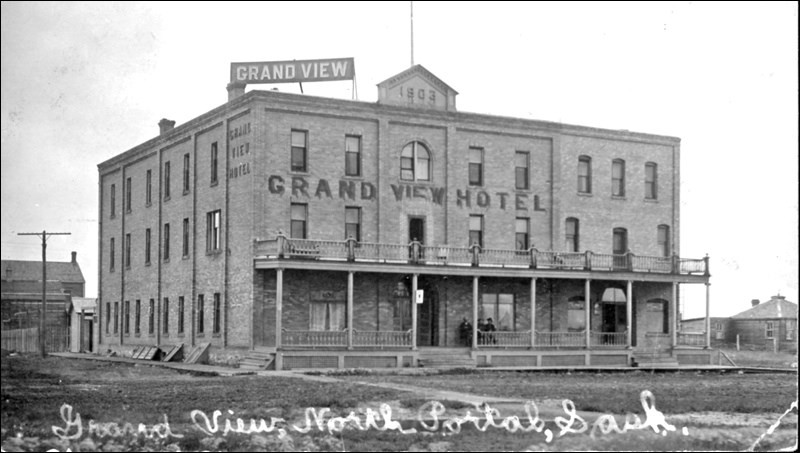The border town of North Portal was a wild and woolly place in the early 1900s, due mainly to the sale of alcohol to residents of North Dakota, a ŌĆ£dryŌĆØ state from 1889 to 1932. Sales of liquor flourished in North Portal from 1903 when the town was founded until 1915 when Saskatchewan implemented its own prohibition laws. Things picked up again after Prohibition ended in 1924 when American rum runners used North Portal as a distribution centre for illegal liquor. The town boasted two hotels located only a few feet from the Canada-US border ŌĆō the Union Hotel and the Grandview Hotel.
North Portal attracted many shady characters from south of the border. In 1906, for example, Corporal Hogg of the Royal North West Mounted Police was called to one of the hotels in town to break up a disturbance. The hotel was full of cowboys led by a gun-toting ŌĆ£notorious bad manŌĆØ named Monaghan, aka Cowboy Jack. Police records state that in the process of arresting Monaghan, the following property was damaged: ŌĆ£door broken; screen smashed up; chair broken; field jacket belonging to Corporal Hogg spoiled by being covered with blood; and the wall plastered with blood.ŌĆØ Monaghan, or Cowboy Jack, is reported to have remarked that if Hogg had not confiscated his gun, another death would have been recorded in Canadian history.
It was into this fray that Louis Kill arrived in 1906. Kill, a German-born representative of the Standard Oil Company, had immigrated to Canada via the USA with his wife, Anna, and their children.
In 1907, after a year with the oil company, Kill decided to take over the Union Hotel in North Portal, built in about 1900. Unfortunately, however, KillŌĆÖs application for a liquor licence for the hotel was unsuccessful. During the provincial liquor commission hearing, the chief licence commissioner stated that, while Louis Kill was, as far as he knew, ŌĆ£of good character,ŌĆØ he doubted whether he was a suitable person to manage a hotel in North Portal which was frequented by ŌĆ£a hard crowd.ŌĆØ In a Regina Leader-Post story, ŌĆ£Roughs Come in from Dakota,ŌĆØ the chairman noted that there had been a good deal of trouble in North Portal. ŌĆ£It is right on the line of a prohibition state and people ŌĆō the very worst element, I am told ŌĆō come over the border for liquor,ŌĆØ he stated. ŌĆ£We would like to see a man who could handle these people.ŌĆØ The commissioners decided to deny KillŌĆÖs application.
Undeterred, Louis Kill bought the hotel at Alameda, about 50 kilometres north of North Portal. He and his family operated the hotel for about three years.
In 1914, William Hetherington, owner of the three-storey Grandview Hotel, was convicted of manslaughter in death of Pat Murphy, alias Kelley, alias Denver Blackie. The crime had been committed during a drunken brawl in the bar of the hotel at the end of August. Shortly after HetheringtonŌĆÖs sentence to two yearsŌĆÖ imprisonment, Louis Kill returned to North Portal and bought the Grandview Hotel.
By 1921, Louis Kill had retired from the hotel business. In the early years, he had made considerable money at the Grandview Hotel. With the passing of bars in Saskatchewan due to Prohibition in 1915, however, hotels had become ŌĆ£white elephants.ŌĆØ The Kill family moved to Sacramento, Calif.
Throughout the 1920s, the Grandview Hotel became the centre for illegal liquor trading as well as gambling, apparently attracting some notorious gangsters from Chicago, including Al Capone ŌĆō incognito. Legend has it that some of the big-winning gamblers never left the Grandview. According to a story in the Winnipeg Free Press on April 8, 1989, some hotel guests disappeared after cleaning up at the gambling table, leaving their belongings and their train tickets untouched in their rooms. It was rumoured that they may have ended up at the bottom of the hotelŌĆÖs 60-metre-deep well.




